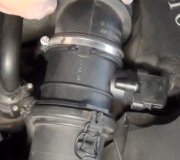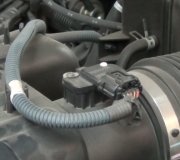A mass airflow sensor is used to determine the mass of air entering an electronically fuel-injected engine. The air mass information is necessary for the engine control unit to calculate and deliver the correct fuel mass to the engine. Air changes its density as it expands and contracts with temperature and pressure. In automotive applications, air density varies with the vehicle's operating environment, and this is an ideal application for a mass sensor.
There are two common types of mass airflow sensors in usage on gasoline engines. They are the vane meter and the hot wire. Neither design employs technology that measures air mass directly. However, with an additional sensor or two, the engine's air mass flow rate can be accurately determined.
Both approaches are used almost exclusively on EFI (electronic fuel injection) engines. Both sensor designs output a 0 - 5.0 volt signal that is proportional to the air mass flow rate, and both sensors have an IAT sensor (intake air temperature) incorporated into their housings.
When a MAF is used in conjunction with an exhaust gas oxygen sensor, the engine's air/fuel ratio can be controlled very accurately. The MAF sensor provides the open-loop predicted air flow information (the measured air flow) to the engine's ECU, and the EGO sensor provides closed-loop feedback in order to make minor corrections to the predicted air mass.
Tuesday, June 5th, 2007 AT 10:57 AM


